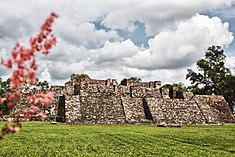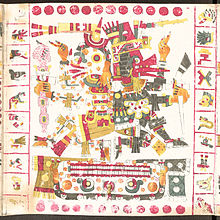
Back ديانة الأزتك Arabic Religión mexica Spanish دین آزتک Persian Religion aztèque French Agama Aztek ID Religione azteca Italian Ацтечка религија Macedonian Religião mexica Portuguese Religia aztecă Romanian Религија Астека Serbian
This article has multiple issues. Please help improve it or discuss these issues on the talk page. (Learn how and when to remove these template messages)
|
 |
| Aztec civilization |
|---|
| Aztec society |
| Aztec history |

The Aztec religion is a polytheistic and monistic pantheism in which the Nahua concept of teotl was construed as the supreme god Ometeotl, as well as a diverse pantheon of lesser gods and manifestations of nature. The popular religion tended to embrace the mythological and polytheistic aspects, and the Aztec Empire's state religion sponsored both the monism of the upper classes and the popular heterodoxies.
The Aztec Empire officially recognized the most popular cults such that the deity was represented in the central temple precinct of the capital Tenochtitlan. The imperial cult was specifically that of the distinctive warlike patron god of the Mexica Huitzilopochtli. Subjugated peoples were allowed to retain their own religious traditions in conquered provinces so long as they added the imperial god Huitzilopochtli to their local pantheons, while the Empire would often incorporate practices from its new territories into the mainstream religion.
In common with many other indigenous Mesoamerican civilizations, the Aztecs put great ritual emphasis on calendrics, and scheduled festivals, government ceremonies, and even war around key transition dates in the Aztec calendar. Public ritual practices could involve food, storytelling, and dance, as well as ceremonial warfare, the Mesoamerican ballgame, and human sacrifice.[1][better source needed]
The cosmology of Aztec religion divides the world into thirteen heavens and nine earthly layers or netherworlds. The first heaven overlaps with the first terrestrial layer, so that heaven and the terrestrial layers meet at the surface of the Earth. Each level is associated with a specific set of deities and astronomical objects. The most important celestial entities in Aztec religion are the Sun, the Moon, and the planet Venus (as both "morning star" and "evening star").
Many leading deities of the Aztecs are worshiped in the contemporary or present-day world. These deities are known by names such as Tlaloc, Quetzalcoatl and Tezcatlipoca, who are venerated by different names in multiple cultures and have been throughout the history of Mesoamerica. For the Aztecs, deities of particular importance are the rain god Tlaloc; Huitzilopochtli, patron of the Mexica tribe; Quetzalcoatl, the feathered serpent and god of wind and learning; and Tezcatlipoca, the shrewd, elusive god of destiny and fortune. Tezcatlipoca was also connected to war and sorcery. Tlaloc and Huitzilopochtli were worshipped in shrines at the top of the largest pyramid (Templo Mayor) in the Aztec capital Tenochtitlan. A third monument in the plaza in front of Templo Mayor was devoted to the wind god, Ehecatl, who was an aspect or form of Quetzalcoatl.[2]
- ^ "Ancient aztec festivals, celebrations and holidays". Mexican Routes [mexicanroutes.com]. 2 May 2019.
- ^ "Study the... WIND GOD". Mexicolore.
© MMXXIII Rich X Search. We shall prevail. All rights reserved. Rich X Search